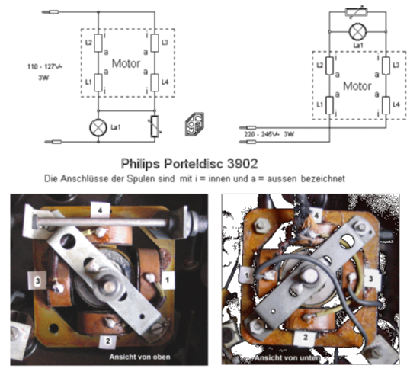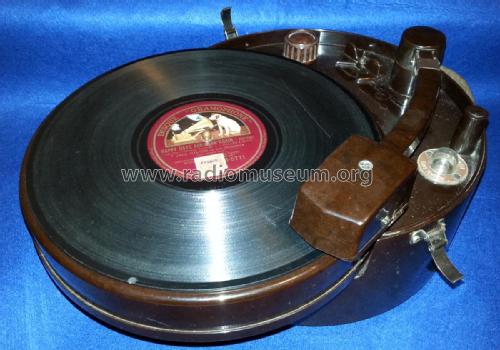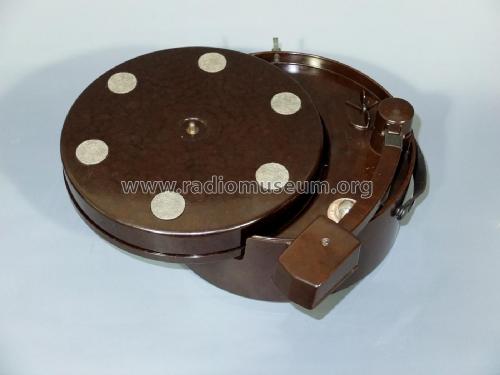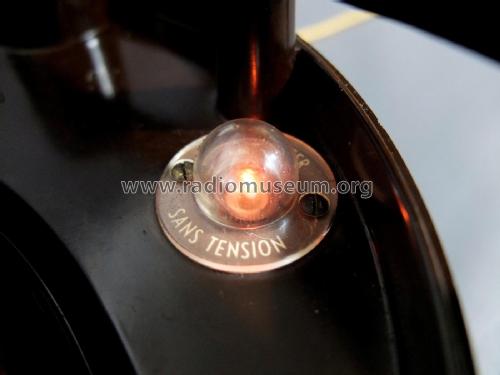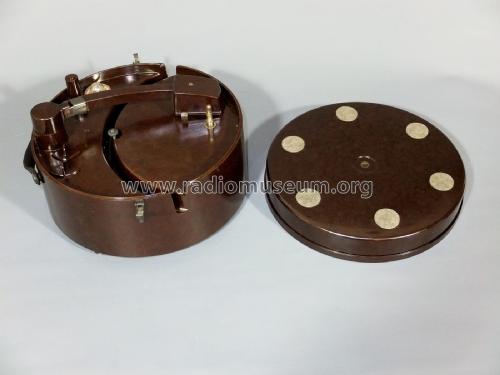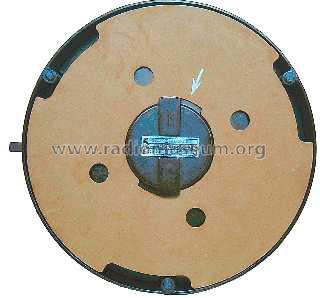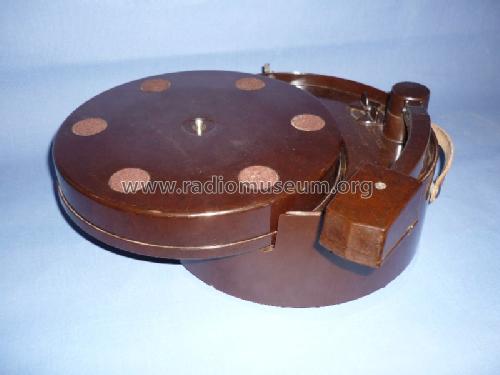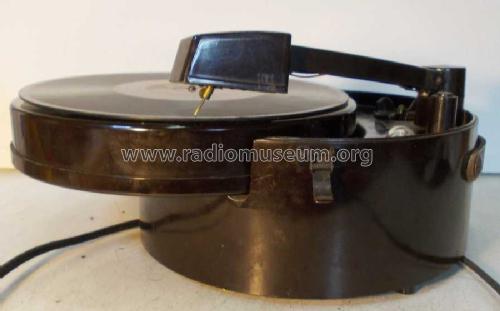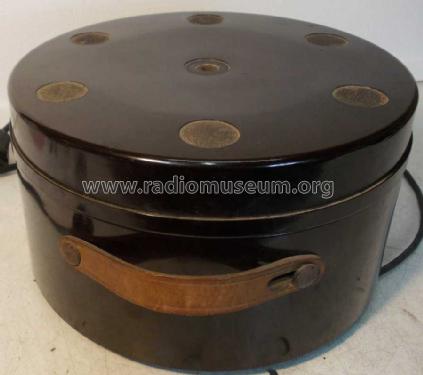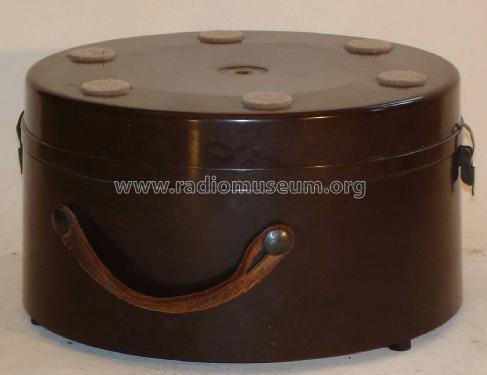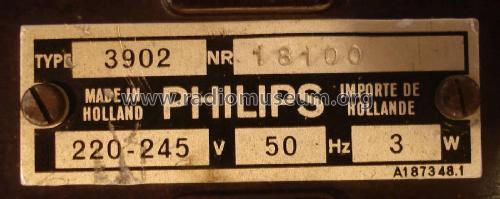Porteldisc 3902
Philips; Eindhoven (tubes international!); Miniwatt
- Country
- Netherlands
- Manufacturer / Brand
- Philips; Eindhoven (tubes international!); Miniwatt
- Year
- 1941
- Category
- Sound/Video Recorder and/or Player
- Radiomuseum.org ID
- 84181
Click on the schematic thumbnail to request the schematic as a free document.
- Details
- Record Player (perh.Changer)
- Power type and voltage
- Alternating Current supply (AC) / 220-245 Volt
- Loudspeaker
- - For headphones or amp.
- Material
- Bakelite case
- from Radiomuseum.org
- Model: Porteldisc 3902 - Philips; Eindhoven tubes
- Shape
- Tablemodel, with any shape - general.
- Dimensions (WHD)
- 260 x 150 x 260 mm / 10.2 x 5.9 x 10.2 inch
- Notes
- magnetic reproducer, needle force 160 g, synchronous motor, not self-starting, 1 phase, 4 poles, 3 Watt
- Net weight (2.2 lb = 1 kg)
- 2.5 kg / 5 lb 8.1 oz (5.507 lb)
- Other Models
-
Here you find 5233 models, 4365 with images and 3445 with schematics for wireless sets etc. In French: TSF for Télégraphie sans fil.
All listed radios etc. from Philips; Eindhoven (tubes international!); Miniwatt
Collections
The model Porteldisc is part of the collections of the following members.
Forum contributions about this model: Philips; Eindhoven: Porteldisc 3902
Threads: 2 | Posts: 15
This must be a Sticky cause it is ESSENTIAL, NEVER dismantel this motor!
NEVER.
The rotor imidiatly looses its magnetic field.
Only if you have an original magnetic service shortadge Cilinder ring, you may be able to dismantel this motor. Read the manual 3902. Its mentioned in it.
See attached Photos how that shortadge ring inside this motor is constructed with 4 sleves
to keep the magnetic field in this rotor, for 80yr. A service shortage cilinder could be of same, I don't know.
Any other way, NEVER take out that rotor.
You can clean the bearings without taken that rotor out.
SO when you did,as I did (even knowing about this but thought 5min would not dare, but it did), or
when you receive a defecive motor in 3902 PortableDisk there is a way to solve the problem.
SOLUTION:
Take 4 very strong magnets. size : 20x10x4 mm.
Re-magnetise material the magnetic field needs to be B>=2 of specs that to be magnetised material.
As I did not know the B of this rotor material , I suspected that current new very strong magnets
would be strong enough.
Place them N-Z-N-Z in a square,Top to bottem, exactly a square.So take your time for positioning.
Check with a 5th magnet the polarization, from a distance cause they are strong :).
Then tape them with electrical-tape, to hold them in position.
Set it aside for at least a full day, I did 2 day's.
Meantime clean other parts, don't forget the bal bearing in the lower bearing.
As you not can take off those magnets, cause you loose again the magnetic-field.
(See also the manual 3902 its mentioned how to replace the rotor)
Position right way the stator(shortage links on top) and put a Tape-roller onderneath that to leave room for that axis.
then place a rubber or plastic ring between Stator and rotor-with still magnets installed.
Put a thick sleave over that top axis or as I did a big plastic cilinder.
That way the magnets have no change to stick to the motor or rotor at wrong places
to again disrupt the new magnetic field.
Push the Rotor in 1 go, and be sure to take magnets away inmediatly.
Be prepaired to inmideatly set power to the motor, as I believe this wil improve
the new magnetic field.
So be fast to let motor run, could be without the series lamp.
Yess you will have little struggle cause its need some rotation to get it going.
Let it run for a minute or 2.
Then try to stop by hand and start again, it should be working now.
Put the whole 3902 PortableDick together and have again a next 80yrs of fun.
Whole story the how and why I had to remove that Rotor and find out the hard way, thinking,
5 minuted would not harm, but it did.
3902-Motor lost its permanent magnic field,help wanted.
Maurice
(See attached fotos how-to)
Attachments
- 3902-New magneticfield-Rotor1-setup (2031 KB)
- 3902-motor-construction1 (28 KB)
- 3902 motor construction 2 (26 KB)
Maurice Hamm, 29.Nov.23
Gerhard Heigl, 18.Mar.08
